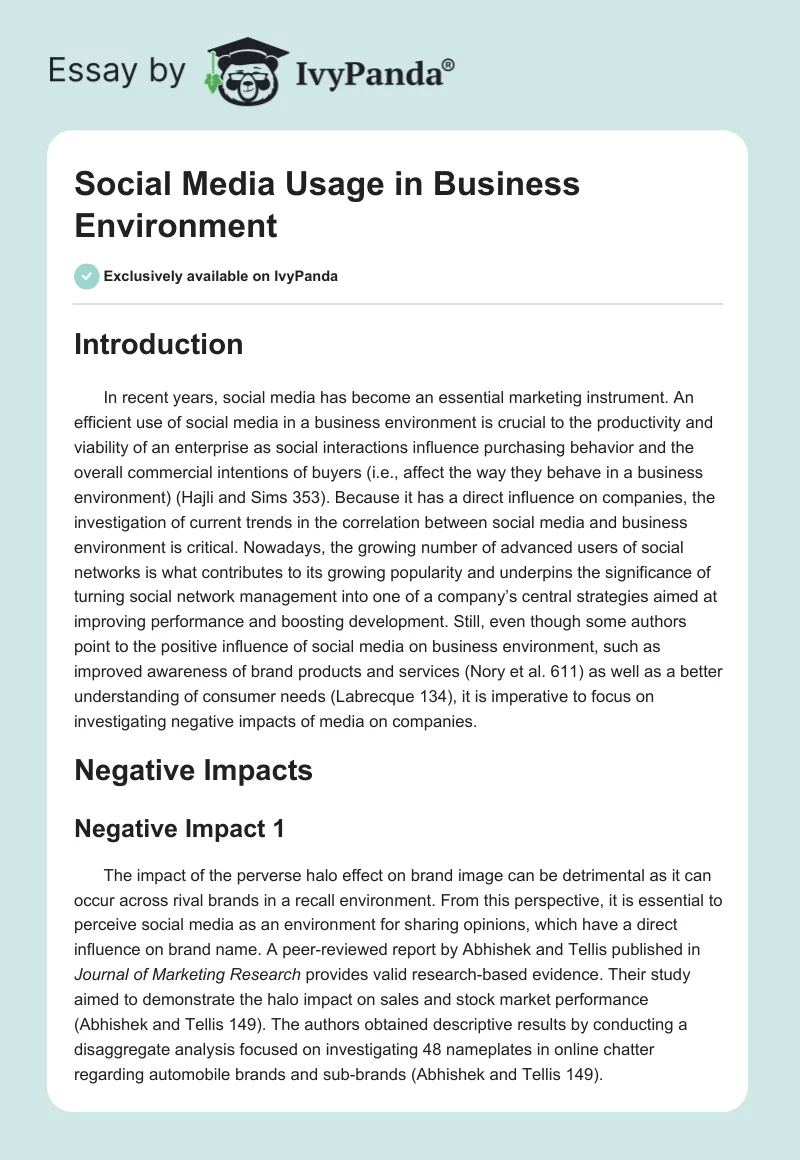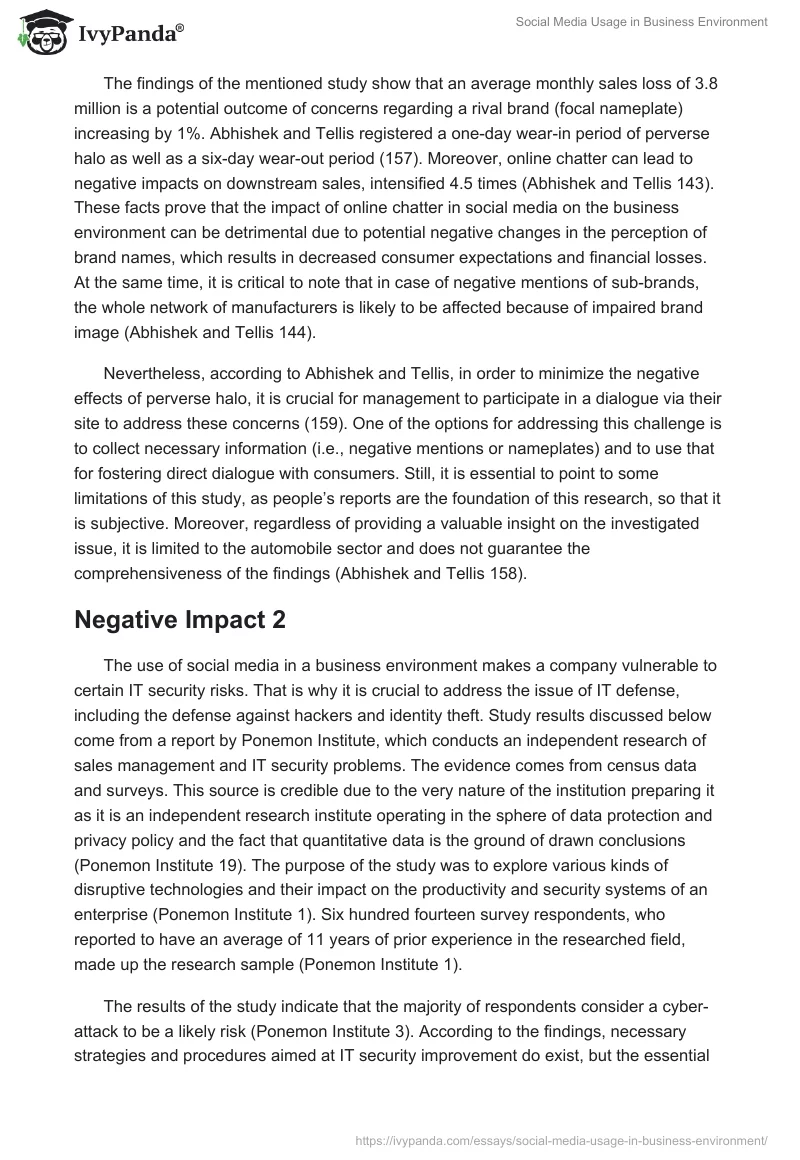Introduction
In recent years, social media has become an essential marketing instrument. An efficient use of social media in a business environment is crucial to the productivity and viability of an enterprise as social interactions influence purchasing behavior and the overall commercial intentions of buyers (i.e., affect the way they behave in a business environment) (Hajli and Sims 353). Because it has a direct influence on companies, the investigation of current trends in the correlation between social media and business environment is critical. Nowadays, the growing number of advanced users of social networks is what contributes to its growing popularity and underpins the significance of turning social network management into one of a company’s central strategies aimed at improving performance and boosting development. Still, even though some authors point to the positive influence of social media on business environment, such as improved awareness of brand products and services (Nory et al. 611) as well as a better understanding of consumer needs (Labrecque 134), it is imperative to focus on investigating negative impacts of media on companies.
Negative Impacts
Negative Impact 1
The impact of the perverse halo effect on brand image can be detrimental as it can occur across rival brands in a recall environment. From this perspective, it is essential to perceive social media as an environment for sharing opinions, which have a direct influence on brand name. A peer-reviewed report by Abhishek and Tellis published in Journal of Marketing Research provides valid research-based evidence. Their study aimed to demonstrate the halo impact on sales and stock market performance (Abhishek and Tellis 149). The authors obtained descriptive results by conducting a disaggregate analysis focused on investigating 48 nameplates in online chatter regarding automobile brands and sub-brands (Abhishek and Tellis 149).
The findings of the mentioned study show that an average monthly sales loss of 3.8 million is a potential outcome of concerns regarding a rival brand (focal nameplate) increasing by 1%. Abhishek and Tellis registered a one-day wear-in period of perverse halo as well as a six-day wear-out period (157). Moreover, online chatter can lead to negative impacts on downstream sales, intensified 4.5 times (Abhishek and Tellis 143). These facts prove that the impact of online chatter in social media on the business environment can be detrimental due to potential negative changes in the perception of brand names, which results in decreased consumer expectations and financial losses. At the same time, it is critical to note that in case of negative mentions of sub-brands, the whole network of manufacturers is likely to be affected because of impaired brand image (Abhishek and Tellis 144).
Nevertheless, according to Abhishek and Tellis, in order to minimize the negative effects of perverse halo, it is crucial for management to participate in a dialogue via their site to address these concerns (159). One of the options for addressing this challenge is to collect necessary information (i.e., negative mentions or nameplates) and to use that for fostering direct dialogue with consumers. Still, it is essential to point to some limitations of this study, as people’s reports are the foundation of this research, so that it is subjective. Moreover, regardless of providing a valuable insight on the investigated issue, it is limited to the automobile sector and does not guarantee the comprehensiveness of the findings (Abhishek and Tellis 158).
Negative Impact 2
The use of social media in a business environment makes a company vulnerable to certain IT security risks. That is why it is crucial to address the issue of IT defense, including the defense against hackers and identity theft. Study results discussed below come from a report by Ponemon Institute, which conducts an independent research of sales management and IT security problems. The evidence comes from census data and surveys. This source is credible due to the very nature of the institution preparing it as it is an independent research institute operating in the sphere of data protection and privacy policy and the fact that quantitative data is the ground of drawn conclusions (Ponemon Institute 19). The purpose of the study was to explore various kinds of disruptive technologies and their impact on the productivity and security systems of an enterprise (Ponemon Institute 1). Six hundred fourteen survey respondents, who reported to have an average of 11 years of prior experience in the researched field, made up the research sample (Ponemon Institute 1).
The results of the study indicate that the majority of respondents consider a cyber-attack to be a likely risk (Ponemon Institute 3). According to the findings, necessary strategies and procedures aimed at IT security improvement do exist, but the essential technological defense systems are often unavailable, as 53 percent of respondents pointed to a lack of necessary technological solutions (Ponemon Institute 3). This means that the very problem of this negative impact of social media is not due to high risks of cyber-attacks. Instead, it derives from unpreparedness to protect companies against these risks. Still, it is crucial to acknowledge a high likelihood of cyber-risks in case the enterprise management employs social media tools (Ponemon Institute 1). To ensure a safe and stable social networking system, it is necessary to improve the computer network’s security structures because cyber-crimes have become increasingly creative in recent years.
Nevertheless, it is vital to keep in mind that there are some limitations of this research, as self-reported results are the foundation of the drawn conclusions (Ponemon Institute 20). It means that when including other people with different backgrounds in a research sample, the results might differ. At the same time, there is no confidence in the reliability of obtained data due to sampling frame bias (i.e., competence of sample representatives) (Ponemon Institute 20).
Negative Impact 3
Employing social media tools can result in a transfer of power from sellers to buyers. This means that it is end-users that possess real economic power and the ability to change a business environment. Hajli and Sims have conducted a study by employing a SEM-PLS model for data analysis, conducting surveys, and collecting census data (Hajli and Sims 350). The Technology Forecasting & Social Change journal published this peer-reviewed article. The purpose of the study was to determine patterns of consumer behavior regarding social networking systems (SNS) as well as predicting future modifications (Hajli and Sims 350). Hajli and Sims demonstrate that SNS such as Facebook are an increasingly significant factor in social change due to free communication among peers and the accessibility of networks to potential consumers (Hajli and Sims 351). From this perspective, SNS shape buying intentions as consumers might want to own particular goods and avoid other products.
The obtained evidence suggests that the consumers’ empowerment is inseparable from social networking strategies the companies employ. It is a substantial change that leads to the power transfer from sellers to buyers (Hajli and Sims 354-355). Because buyers are subject to a transformation, they play an active role as content generators instead of a traditional function of consumers of particular goods (Hajli and Sims 354-355). It means that they possess real power to boost demand for some goods that they perceive as prestigious or of better quality. From this perspective, it is critical to deploy social media management strategies by focusing on direct communication with potential consumers with an emphasis on providing relevant information about a product or service instead of inaccurate facts shared online.
Still, it is vital to point to the limitations of this research as UK residents made up the foundation of the research sample (Hajli and Sims 356). This means that obtained information is accurate in the British business environments and UK companies. Nevertheless, businesses conducting operations in other countries might still find interest in this research due to the growing popularity of social media as a communication platform.
Summary
Based on data-driven evidence, it is possible to conclude that social media networking systems constitute a major factor of change in consumer behavior and buyer intentions (Hajli and Sims 354) while, at the same time, affecting brand image (Abhishek and Tellis 149). Moreover, there is an increasingly widespread practice of applying social media marketing leads to serious risks regarding IT security systems (Ponemon Institute 1). Keeping these findings in mind, it is essential to point to the fact that companies might deploy them for obtaining a better understanding of the modern business environment, which is inseparable from social media. This data points to the growing role of social media in establishing relations with consumers (De Vries et al. 1). Managers might use this knowledge for improving brand image as well as recommending investment in social media networking support and upgrading IT security system development.
Works Cited
Abhishek, Borah, and Gerard J. Tellis. “Halo (Spillover) Effects in Social Media: Do Product Recalls of One Brand Hurt or Help Rival Brands?” Journal of Marketing Research, vol. 53, no. 2, 2016, pp. 143-160.
De Vries, Lisette, et al. “Popularity of Brand Posts on Brand Fan Pages: An Investigation of the Effects of Social Media Marketing.” Journal of Interactive Marketing, vol. 26, no. 2, 2012, pp. 83-91.
Hajli, Nick, and Julian Sims. “Social Commerce: The Transfer of Power from Sellers to Buyers.” Technological Forecasting and Social Change, vol. 94, no. 1, 2015, pp. 350-358.
Labrecque, Lauren. “Fostering Consumer-Brand Relationships in Social Media Environments: The Role of Parasocial Interaction.” Journal of Interactive Marketing, vol. 28, no. 2, 2014, pp. 134-148.
Nory, Jones, et al. “Impact of Social Media on Small Businesses.” Journal of Small Business and Enterprise Development, vol. 22, no. 4, 2015, pp. 611-632.
Ponemon Institute. Global Survey on Social Media Risks: Survey of IT & IT Security Practitioners. Traverse, 2011.

 4.28
4.28
